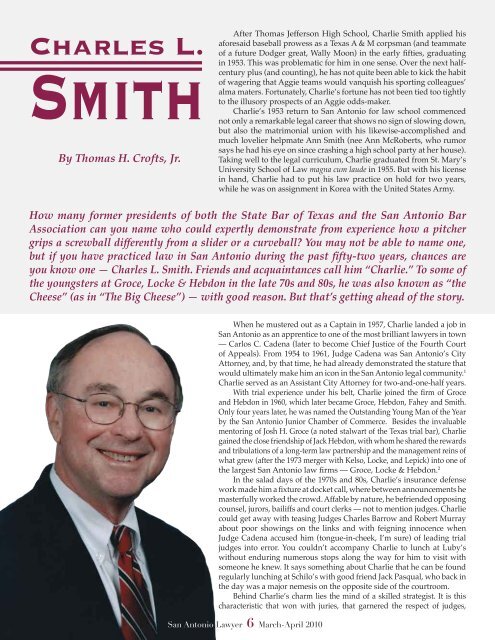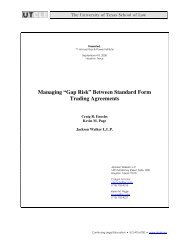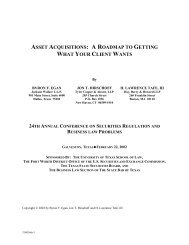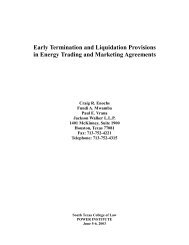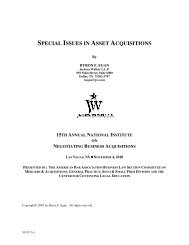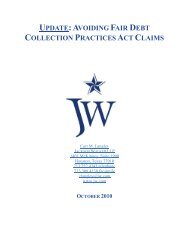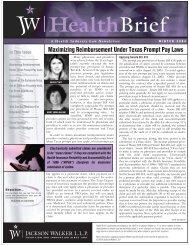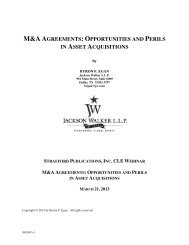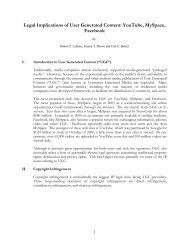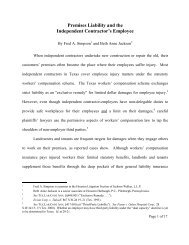Charles L. Smith - Jackson Walker LLP
Charles L. Smith - Jackson Walker LLP
Charles L. Smith - Jackson Walker LLP
You also want an ePaper? Increase the reach of your titles
YUMPU automatically turns print PDFs into web optimized ePapers that Google loves.
<strong>Charles</strong> L.<strong>Smith</strong>By Thomas H. Crofts, Jr.After Thomas Jefferson High School, Charlie <strong>Smith</strong> applied hisaforesaid baseball prowess as a Texas A & M corpsman (and teammateof a future Dodger great, Wally Moon) in the early fifties, graduatingin 1953. This was problematic for him in one sense. Over the next halfcenturyplus (and counting), he has not quite been able to kick the habitof wagering that Aggie teams would vanquish his sporting colleagues’alma maters. Fortunately, Charlie’s fortune has not been tied too tightlyto the illusory prospects of an Aggie odds-maker.Charlie’s 1953 return to San Antonio for law school commencednot only a remarkable legal career that shows no sign of slowing down,but also the matrimonial union with his likewise-accomplished andmuch lovelier helpmate Ann <strong>Smith</strong> (nee Ann McRoberts, who rumorsays he had his eye on since crashing a high school party at her house).Taking well to the legal curriculum, Charlie graduated from St. Mary’sUniversity School of Law magna cum laude in 1955. But with his licensein hand, Charlie had to put his law practice on hold for two years,while he was on assignment in Korea with the United States Army.How many former presidents of both the State Bar of Texas and the San Antonio BarAssociation can you name who could expertly demonstrate from experience how a pitchergrips a screwball differently from a slider or a curveball? You may not be able to name one,but if you have practiced law in San Antonio during the past fifty-two years, chances areyou know one — <strong>Charles</strong> L. <strong>Smith</strong>. Friends and acquaintances call him “Charlie.” To some ofthe youngsters at Groce, Locke & Hebdon in the late 70s and 80s, he was also known as “theCheese” (as in “The Big Cheese”) — with good reason. But that’s getting ahead of the story.When he mustered out as a Captain in 1957, Charlie landed a job inSan Antonio as an apprentice to one of the most brilliant lawyers in town— Carlos C. Cadena (later to become Chief Justice of the Fourth Courtof Appeals). From 1954 to 1961, Judge Cadena was San Antonio’s CityAttorney, and, by that time, he had already demonstrated the stature thatwould ultimately make him an icon in the San Antonio legal community. 1Charlie served as an Assistant City Attorney for two-and-one-half years.With trial experience under his belt, Charlie joined the firm of Groceand Hebdon in 1960, which later became Groce, Hebdon, Fahey and <strong>Smith</strong>.Only four years later, he was named the Outstanding Young Man of the Yearby the San Antonio Junior Chamber of Commerce. Besides the invaluablementoring of Josh H. Groce (a noted stalwart of the Texas trial bar), Charliegained the close friendship of Jack Hebdon, with whom he shared the rewardsand tribulations of a long-term law partnership and the management reins ofwhat grew (after the 1973 merger with Kelso, Locke, and Lepick) into one ofthe largest San Antonio law firms — Groce, Locke & Hebdon. 2In the salad days of the 1970s and 80s, Charlie’s insurance defensework made him a fixture at docket call, where between announcements hemasterfully worked the crowd. Affable by nature, he befriended opposingcounsel, jurors, bailiffs and court clerks — not to mention judges. Charliecould get away with teasing Judges <strong>Charles</strong> Barrow and Robert Murrayabout poor showings on the links and with feigning innocence whenJudge Cadena accused him (tongue-in-cheek, I’m sure) of leading trialjudges into error. You couldn’t accompany Charlie to lunch at Luby’swithout enduring numerous stops along the way for him to visit withsomeone he knew. It says something about Charlie that he can be foundregularly lunching at Schilo’s with good friend Jack Pasqual, who back inthe day was a major nemesis on the opposite side of the courtroom.Behind Charlie’s charm lies the mind of a skilled strategist. It is thischaracteristic that won with juries, that garnered the respect of judges,San Antonio Lawyer 6 March-April 2010
and that endeared him to clients. He wasprobably the first candidate for State BarPresident who utilized diagrammed wallmapsof Texas geography and color-codedpins to leave no vote unasked-for in hissuccessful 1984 campaign for President-Elect. During the next year, President<strong>Smith</strong> led the Bar through one of themost profound changes in its history— the adoption of mandatory MinimumContinuing Legal Education. Charlie’sbelief in the merit of this then-controversialidea did produce some dissident sarcasm(like “thanks a lot, Charlie”), but twentyfiveyears later, there can be no doubt thathis work for the passage of MCLE wasright on target. Thanks a lot, Charlie. 3In-house in the 1970s and early 80s,gentleman Jack Hebdon was the man incharge, but Charlie <strong>Smith</strong> was the handsonboss. He carried out this authority witha low-key but determined exactitude.It cannot be said that Charlie’s partnersagreed with each of his managementdecisions. But who could quarrel withinnovations like two-gender/multi-ethnichiring and enlisting professional legalassistants? In assigning work, Charliestrived to promote efficient organization oflitigation files among specialized practicegroups. For example, it was his idea thatinaugurated the first law firm appellatepractice section in San Antonio. 4Charlie’s supervision of the associateranks at Groce, Locke & Hebdon is thestuff of legend. The storied details of therelationship are beyond the scope of thisreport, but one memory stands out asillustrative of his position. In the mid 70s,we down-trodden associates were invitedperiodically to attend the opening segmentof the partners’ weekly meetings. Seizingthe opportunity, we customarily gatheredon the meeting-eve in a small diningroom above the Esquire Bar (“theUpper Room”) to formulate a bill ofgrievances for presentation the nextmorning when Charlie asked, “Doesany associate have something tosay?” Thanks to a waiter’s repeatedtrips up from the bar, eloquentresponses were inevitably articulatedthe night before. But in the soberlight of Charlie’s penetrating gaze,they usually were voiced in a fewawkward stammers and meek “nosirs.” His ritual conclusion was toask if we had enough work (I don’trecall his ever asking if we had toomuch) before dismissing us fromthe conference room.As things boomed in the 1980s,Charlie had his hands full with theaddition of many bright new litigationhires. With them, somebody had tobe the “big cheese,” and he was it.Most who began under Charlie’swing would say that his guidance hadan unforgettable impact. Charlie was agood teacher (certain questions shouldalways be asked of a deponent andcertain things should not be disclosed innegotiations). He praised fine work andhelped constructively with mistakes. Bestof all, he became a friend who inspiredby caring deeply for his law firm andthe well-being of its lawyers and staff.Charlie enthusiastically rallied the troopsas coach of the firm’s winning softballteams. He and Ann hosted delightfulretreats at the <strong>Smith</strong> family’s McQueeneylake house. 5 He still has an absolutelyuncanny knack for remembering thenames, faces, and situations of spouses,children, and significant others, and healways goes out of his way to inquireCharlie in his A&M baseball days at Kyle Fieldabout them and to greet them warmly.Is it any wonder, then, that Charliehas been honored widely and repeatedly?The recognitions he has acquired wouldtake a separate edition to enumerate.Here are just a few:• Lola Wright Foundation Awardfrom the Texas Bar Foundation forOutstanding Public Service in theEnhancement of Legal Ethics;• Lifetime Achievement Award bySt. Mary’s University School of Law;• Distinguished Law Alumnusby the Law Alumni Association ofSt. Mary’s University;1Judge Cadena taught at St. Mary’s University School of Law for several years before becoming City Attorney. During that time, he argued andwon a landmark case in the United States Supreme Court, which established that people could not be excluded from jury service because ofnational origin. More details can be found in successor Chief Justice Phil Hardberger’s memorial tribute to Judge Cadena published in Volume62 of the Southwestern Reporter Third Series.2In the summer of 1973, this writer applied for a job with the newly formed firm and happily accepted Charlie’s offer to become Groce, Locke& Hebdon’s first associate hire and twentieth attorney (after he deftly negotiated me down from my stated salary requirement). The firm’s sizesteadily grew to more than one hundred lawyers in 1990.3<strong>Charles</strong> L. <strong>Smith</strong>’s major State Bar contributions also include two periods of service on the Board of Directors, including the chairmanship in1980-81. He was on the Board when another landmark event occurred in 1984 -- the adoption of IOLTA. He has also chaired the Commissionon Judicial Conduct, as well as the Commission for Lawyer Discipline, and has served on the Board of Disciplinary Appeals.4As a result, this writer was converted in the mid-70’s from the latest stint of questionable service in each of the other sections to become theoriginal head of the appellate section (and, for a while, the foot as well).5Speaking of family, Charlie and Ann’s own offspring should be recognized. Both Jimmy and Larry were drafted into the law firm’s courier cadre atvarious times in their teenage and young adult years. Jimmy (Dr. James <strong>Smith</strong>), who now practices medicine in New Orleans, and wife Monica arethe parents of Austin and George. Larry (Lawrence D. <strong>Smith</strong>) followed the footsteps to law school (SMU), and, having begun his employment-lawpractice as an associate at Groce, Locke & Hebdon, is now a San Antonio partner in Ogletree Deakins Nash Smoak & Stewart. Larry and wife Kim arethe parents of Timothy, Zander, and David. Holly <strong>Smith</strong>, Charlie and Ann’s daughter, has a career in education for children with special needs.San Antonio Lawyer 7 March-April 2010
• Joe Frazier Brown Award by the San Antonio Bar Associationfor Outstanding Leadership and Service to Legal Profession andCitizens of Texas;• Carol Lomax Memorial Award by San Antonio Chapterof American Board of Trial Advocates for Exemplary Integrity,Civility and Professionalism;• Outstanding 50-Year Lawyer Award by the Texas BarFoundation; and• Attorney of the Year by the Texas Aggie Bar Association.Meanwhile, Charlie has litigated more than three hundred jurytrials and has handled thousands of all kind of cases.Most things change, of course. Groce, Locke & Hebdon merged withJenkens & Gilchrist in 1996. Jenkens & Gilchrist ceased to exist in 2007. Now,Charlie is Senior Counsel at<strong>Jackson</strong> <strong>Walker</strong>, L.L.P. Butotherwise, he does not seemto have changed all thatmuch. Look on page 8 of yourSeptember 2009 Subpoena(Vol. LXXXV Number 2).There you will see a dapper<strong>Charles</strong> L. <strong>Smith</strong> holdinghis new Community JusticeProgram file and facingthe camera with a broadsmile alongside his currentyoung protégés.Thomas H. Crofts, Jr. leftGroce, Locke & Hebdonin 1991, along with twocolleagues, to form Crofts,Callaway & Jefferson asa civil appellate practicefirm. The firm continuesas Crofts & Callawayunder the leadership ofSharon E. Callaway, with Tom Crofts as “OfCounsel.” Wallace B. Jefferson was appointed tothe Supreme Court of Texas in 2000 and is nowthe State’s elected Chief Justice.Above: Charlie with wife Ann at the American Embassyin Paris, during his term as Texas State Bar President.Below: The entire family in Hawaii for Charlie and Ann’s50 th wedding anniversary.San Antonio Lawyer 8 March-April 2010


